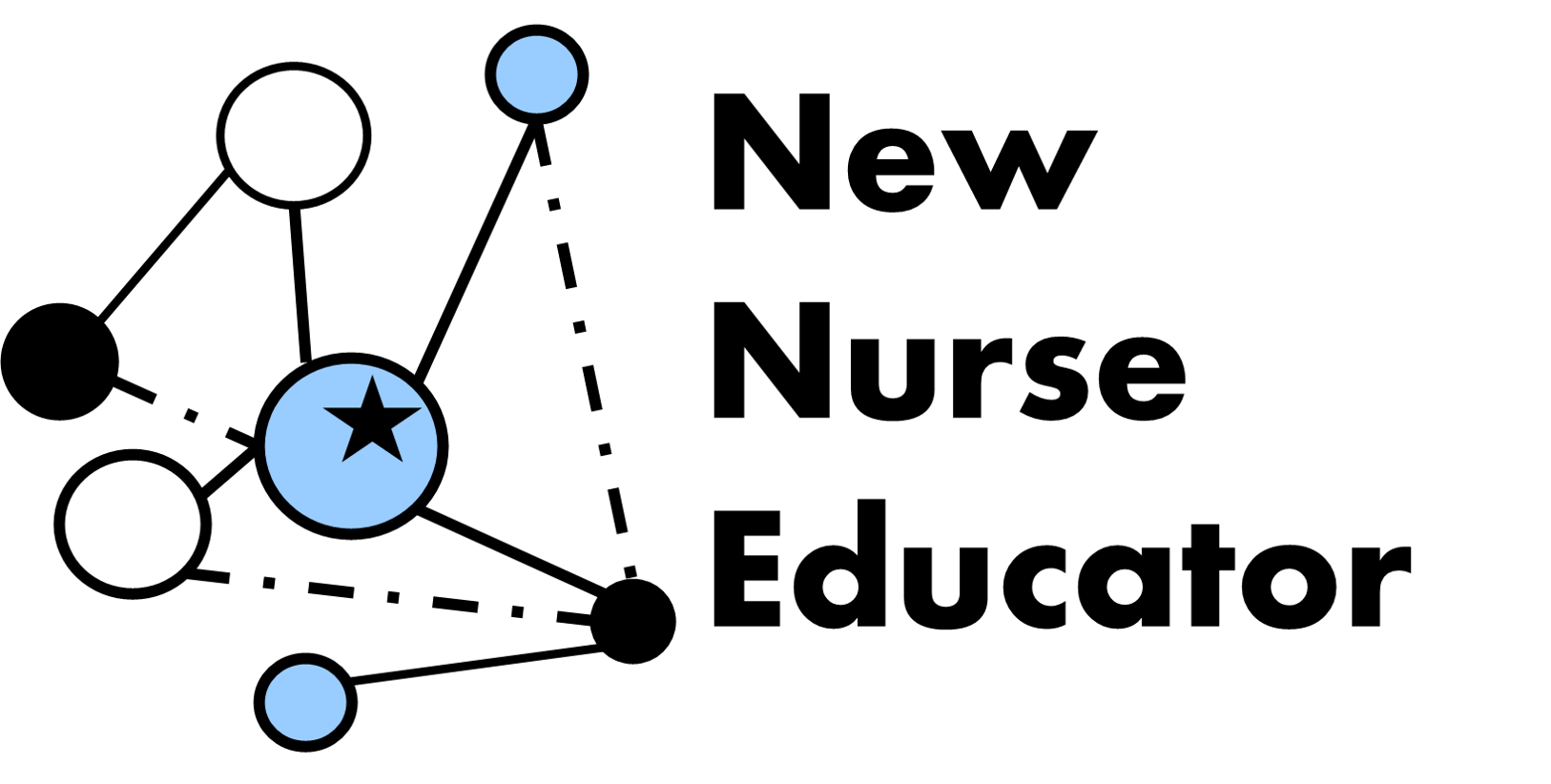Author: Leena Salminen
Professor, Leader and coordinator of the project
University of Turku, Department of Nursing Science
A New Agenda for Nurse Educator Education in Europe –project has ended in this Autumn. We can say, we have taken the first steps in harmonizing the nurse educator education within Europe. The results of our project are promising. The nurse educator programme (30 ECTS) conducted during the project was success and even more important, it was found to be an illustrative example of organizing the common European nurse education with varying teaching methods and modern contents. The learning outcomes were good, the students were satisfied with the programme even it was hard-working. All in all, the evaluated competence of nurse educators was at the good level (Elonen et al., 2023; Vauhkonen et al., 2024), but there is a need for systematic continuing professional development (Smith et al., 2023).
How did we do all this?
First of all, we had an amazing good and motivated project group. The group consisted of partners from five European countries (Finland, Malta, Scotland, Slovakia and Spain) and six universities (two from Finland). At the beginning of the project, we had partners also from German, but unfortunately, they withdraw the project for their organizational reasons. The
co-operation went very well all the time. Even we were all hurry, somehow all partners found the time to make this project. One of the reasons might be that this is so interesting and unique, never done before. The atmosphere in the group was open and discussing, and we supported each other. We also have fun!
Secondly, we had a quite good project plan done when applying the funding. We have prepared and written it together. We all agreed the aims and tasks planned to do during this project. It increased the commitment to the project. We had also planned “double cast” for every intellectual output and that way we ensured the tasks going on and get ready in time. Of course, we didn’t manage every task and the deadlines came too early but all in all, quite nicely.
Thirdly, we had time to make the project. This was three years EU funded project. This meant also that we have to prepare everything: tasks, responsibilities, schedule, and expected outcomes very carefully in time and beforehand. We had meetings at least every month, sometimes even often. It promoted our work.
Fourthly, we have a very good co-operation with the funder, and we were supported by our university concerning the financial things. Also, our National Erasmus Agency supported us and answered our questions quickly. We had strictly ruled with our partners concerning the financial things. It helped us to keep understanding the financial situation, how much we have money left and where we have spent it.
What could we have done better?
Of course, in every project there is something that to do better. We conducted quite much research during our project. One aim of this project was to set recommendations for future nurse educators’ qualifications and education, and we wanted it base on evidence. The research took time more time than we had estimated. It was not so easy to collect the data in five countries because they all have different kind of rules and legislation of research protocols.
The other thing we could have done better is sharing the knowledge we have produced. We have written many research articles, some of them are already published and some are still under review. You can follow our website to find the articles.
We need an agenda for nurse educator education
We need a new agenda for nurse educator education in Europe and it must be based on evidence. Only that way we can promote nurse educators’ qualification and competence. Nurse education needs excellent more than ever in this changing society and in emerging health care. Nurse educators have an important role implementing it. Only this way the patients can get the best care.
Merry Christmas
Finally, I want to thank all my project members for their hard, innovative and important work during the project. Without you, this has never been possible.
Also, I want to thank the funder, Erasmus+, giving possibility to conduct our project. This was our common dream, and we managed to do it.
I wish you all Merry Christmas and Prosperous New Year with the new projects.
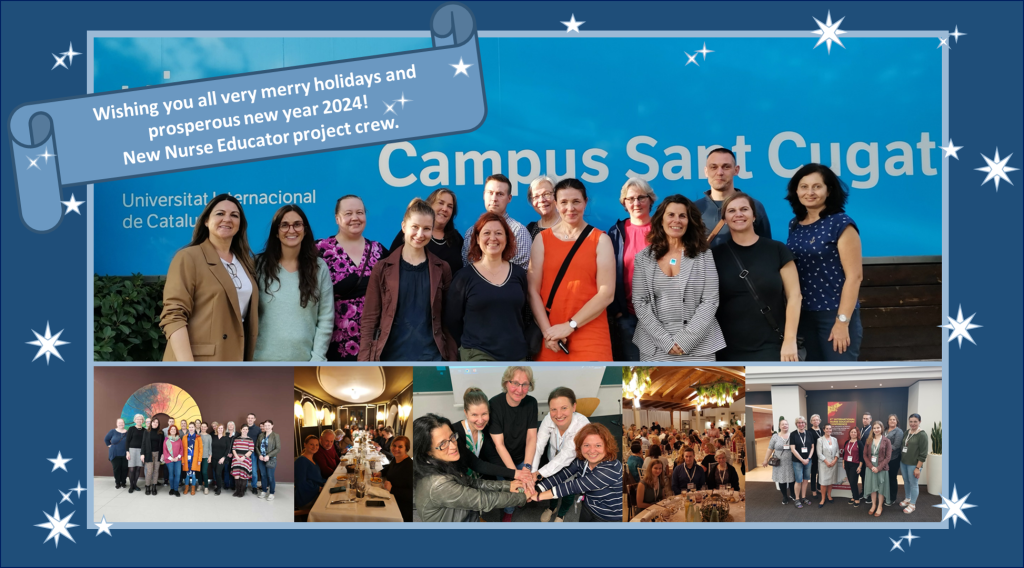
References:
Elonen I, Kajander-Unkuri S, Cassar M, Wennberg-Capellades L, Kean S, Sollár T, Saaranen T, Pasanen M & Salminen L. 2023. Nurse Educator Competence in Four European Countries – A Comparative Cross-sectional Study. Nursing Open. 00, 1–12. DOI: 10.1002/nop2.2033
Smith J, Kean S, Vauhkonen A, Elonen I, Campos Silva S, Pajari J, Cassar M, Martin-Deldago L, Zrubcova D & Salminen L. 2023. An integrative review of the continuing professional development needs for nurse educators. Nurse Education Today. doi.org/10.1016/j.nedt.2022.105695
Vauhkonen A, Saaranen T, Cassar M, Camilleri M, Martin-Delgado L, Haycock-Stuart E, Solgajová A, Elonen I, Pasanen M, Virtanen H & Salminen L. 2024. Professional Competence, Personal Occupational Well-Being, and Mental Workload of Nurse Educators – A Cross-Sectional Study in Four European Countries. Nurse Education Today 133. https://doi.org/10.1016/j.nedt.2023.106069
Authors: Professor Leena Salminen, Project researcher Imane Elonen
Empowering the Nurse Educators in the Changing World –study programme was developed, as a first step towards joint nurse educator education in Europe. During our educator education programme a great variety of distance teaching and learning methods were used to give participants equal opportunities to participate and enable self-directiveness at the same time. This called a great amount of support and mentoring for the students during the studies. In our project we think mentoring as partnership which contains authentic communication, enriching support, sharing knowledge (Busby et al., 2023) and supervising the studies.
Definition, content and forms of mentoring
Mentoring has been found to be an important thing to adapt new faculty to teaching and socialize them to the academic community (Webber et al., 2020). Mentoring contributes to career development through a continuous learning process and support for role development (Costa & Smith, 2023). Mentoring is often defined as a relationship between a more experienced mentor and a less experienced mentee for the purpose of supporting the mentee’s competence and career (Busby et al, 2022), but it is also considered as a support and guidance during the studies and career development (van Dongen et al., 2023.).
Mentoring can have different forms, e.g. formal mentoring, where mentors are assigned to mentees; informal mentoring, based on social attraction between the mentee and mentor; peer mentoring and group mentoring, where multiple mentors support the mentee (Busby et al., 2022). For novice nurse educator entering in nursing education without guidance and support, the transition can be frustrating and lead to career dissatisfaction. Mentoring can be one of the most important things for the successful learning process and also transition to academia, inspiring confidence in new nurse educators. Therefore, we aimed to mentor our student during the nurse educator education program.
Student online mentoring was activity conducted during the whole study programme “Empowering the nurse educators in the changing world”. Mentoring included guiding and instructing the students in the use of the learning environment, helping the students to access the study materials and tasks and supporting to use and utilize the technical solutions and applications used. Also, the educator professional development and career was discussed. The more experienced participants mentored and guided the less experienced participants. The participants wrote the learning diary to reflect their experiences and what they have learnt.
Elements of mentoring
Mentoring in the study programme consisted of three main elements. Techinical support and practical information, online mentoring with the study programme content and learning process, and on-site mentoring during the Empowering Learning Environments in Nursing Education (ELENE) intensive week and teacher training week during Evidence-Based Teaching (EBT) study unit. Technical support and practical information, and online mentoring with the study programme content and learning process was ongoing throughout the whole study programme. On-site mentoring occurred during the two week long on-site studying and training.
Technical support
Technical support and practical information started already before the study programme started, with preparation of material for students, who come from different backgrounds and countries. Written instructions with informative images were prepared, to ease the enrollment process and access of the digital environment and resources. Furthermore, after the enrollment, students received also one on one guidance via phone, e-mail and video conferencing tools, in case they had trouble accessing the learning platform or finding necessary materials or resources there. In addition, students could approach one of the instructors throughout the study programme. There were various instructors conducting mentoring during the study programme, but there was one instructor from University of Turku, assigned to keep in touch with the students throughout the whole 10-month programme. Students could self-determine the means they contacted the instructors, phone, e-mail or video conferencing. The learning platform news was utilized often, and instructors forwarded information and reminders about the learning tasks and deadlines and practical arrangements of the studies and travels.
Online mentoring
Similarly, as technical and practical support, online mentoring with the study programme content and learning process started already before the study programme started. Students who pondered participation and their own abilities to complete the study programme or some of the units, were guided and informed about the requirements and content of the study programme. The mentoring of the studies, started already on the second week of the programme, during ELENE online teaching. All students were invited to a video conferencing, should they need guidance in their group work. This was repeated also on the third week after a request from the students. Furthermore, guided group work was utilized in almost all of the study units.
In ELENE and Global Health Issues, there were two sessions of guided group work, and in Issues in Future Nurse Education (IFNE) and Ethics and Nurse Educators’ Work (ENEW) there were weekly online guided group work sessions. In addition, two study units, EBT and ENEW had a question hour. In EBT the question hour was about the practical and theoretical content and requirements of the teacher training, in ENEW the students had an opportunity to ask questions about the content of the study unit from an ethics expert.
Online mentoring was utilized also for preparation of the on-site elements of the programme. Before ELENE, students received information and instructions about practical arrangements. Communication was frequent, as the ongoing Covid-19 pandemic and constantly changing restrictions and travel requirements caused plenty of uncertainty. Students received information and guidance about anything and everything related to traveling to Turku in the after waves of the global pandemic. Before EBT teacher training, the students had several online meetings with the receiving universities. They were guided in their preparations for the teacher training and presentations and teaching sessions that were expected from them during the training week, as well as practical issues about travel and accommodation, including frequent weather broadcasts and assurance the people coming from warmer climate would cope in the winter of the colder climate countries.
On-site mentoring
On-site mentoring, lasted for the two weeks students were visiting the organizing universities. On-site mentoring during ELENE was guided group works and helping students to find places where they needed to be. During EBT teacher training, on-site mentoring varied from place to place, as each and every receiving university had created individual programmes, based on the training opportunities and schedules and local expertice. Study visits were arranged in all of the universities to different collaboration partners and some extra curricular activities were also arranged to make the students feel welcome and give them opportunity to get familiar with the culture they were visiting. Students were also offered guidance during their learning tasks and the instructors in the universities shared their own experiences and expertise with the students.
Summary
Mentoring, during the Empowering the Nurse Educators in the Changing World study programme was successful, as majority of the students completed the study units they started, which is positive considering that online education has usually high dropout rates (Wang et al., 2019). During the study programme, the mentoring was seen as an ongoing process rather than a designed task. The mentors were available and listened to the students, and the structure of the guidance was altered based on feedback from the students. The regular availability of the mentors and guidance for social interaction, may have improved the completion rate. (Wang et al., 2019.) Furthermore, mentoring was not limited to instructors mentoring the students, but the students stated learning from each other’s experiences and expertice as well.
References
Busby, K.R., Draucker, C.B., Reising, D.L., 2022. Exploring mentoring and nurse faculty: an integrative review. J. Prof. Nurs. 38, 26–39. https://doi.org/10.1016/j. profnurs.2021.11.006
Busby, K.R., Draucjer, C.B., & Reising D.L. 2023. Mentoring-as-Partnership: The Meaning of Mentoring Among Novice Nurse Faculty. Journal of Nursing Education 62 (2), 83-88. DOI: 10.3928/01484834-20221213-03
Costa CB., & Smith JE. 2023. Career Satisfaction and Advancement Related to Mentorship Experiences of Underrepresented Nursing Faculty.Nurse Education Perspective 44(5), 291-294 doi: 10.1097/01.NEP.0000000000001173
van Dongen, L.J.C., Leino-Kilpi H., Jónsdóttir, H.J., Meyer, G., Henriques, M.A., Schoonhoven, L., Suhonen, R., & Hafsteinsdóttir, T.B. 2023. The experiences of doctorally prepared nurses and doctoral nursing students with being mentored in the Nurse-Lead programme: A focus group study. Nurse Education in Practice, epub. https://doi.org/10.1016/j.nepr.2023.103744
Wang, W., Guo, L., He, L., & Wu, Y. J. (2019). Effects of social-interactive engagement on the dropout ratio in online learning: insights from MOOC. Behaviour & Information Technology, 38(6), 621-636.
Webber, E., Vaughn-Deneen, T., & Anthony, M. 2020. Three-Generation Academic Mentoring Teams – A New Approach to Faculty Mentoring in Nursing. Nurse Educator 45(4), 210-213. DOI: 10.1097/NNE.000000000000077
We were all students once and we know what we liked about education, various methods, and teachers’ approaches and attitudes. As teachers, we use this experience and knowledge whether we realise it or not. In addition to the formal and widely used teaching strategies, we often act intuitively using our own ideas, techniques, and strategies When we share this information and when we say things aloud, we realise that other teachers use similar ideas, techniques, and strategies and adapt them to new situations. Together we can develop them, give them names, and thus make them part of formal education. One sentence activates another, which makes us see things in new perspectives. New ideas occur, and changes are made because everything is constantly in motion. Despite or thanks to the spatial distance and cultural differences, we produce better ways and solutions in our mission to improve nurse educator education, and thus care for patients.
This suggests the importance of collaboration between teachers, nurses, and scientists locally, nationally, and internationally. International collaboration in this project includes participation in classes, group meeting, workshops, seminars, and conferences. Both face-to-face and online meetings allow sharing the ideas, motivations, experiences, rationale, study results, strengths and limitations, and challenges and suggestions for the future. Various backgrounds of the participants are a great asset and enrichment for the development of ideas and achieving common goals.
Furthermore, international collaboration is important because health-related beliefs and needs may vary in patients who come from different backgrounds, cultures, or countries. The project activities, such as designing teaching plans, problem solving, writing papers, and exploring other issues draw attention also to those particularities.
Proximity means nearness or closeness in distance or time. We have become close not only in time and (online) space but also in our eagerness to learn new things, broaden our horizons and improve nurse educator education through open cross-border interaction.
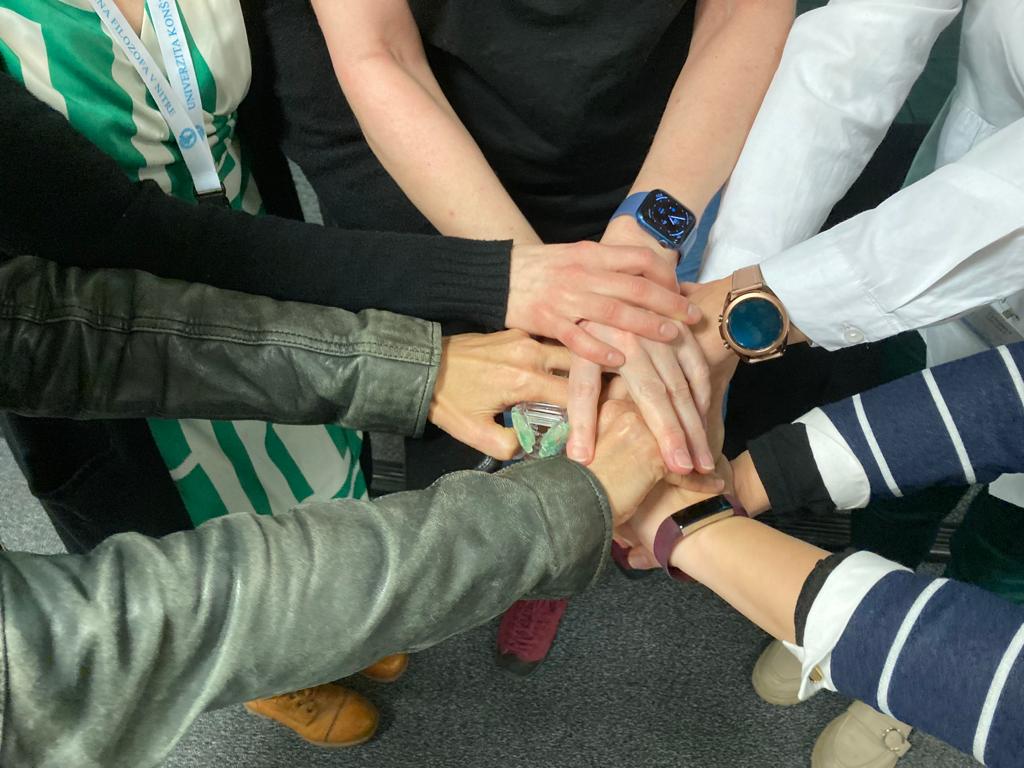

The authors of the blog are (from left to right):
Tomas Sollar, Andrea Solgajová, Ľuboslavá Pavelova and Dana Zrubcova from Constantine the Philosopher University in Nitra, Slovakia.
“To make the invisible more visible to others, is after all, a major goal of the interpreter”
(Denzin 2010: 32).
A blog post from Susanne Kean. The University of Edinburgh.
Mapping or modelling is one way of making the invisible more visible to the researcher and, eventually, to the reader of research. Mapping or modelling are data analysis techniques that come into play after the first round of analysis. These techniques can be used independent of methodology. To explain this technique, I will draw on Thematic Analysis (TA) and coding.
Coding, of course, is only one way of analysing data and not THE way. Coding originates in Grounded Theory but is today used well beyond this methodology. TA is an example where coding is used as an analytical device. A code, Saldaña (2021) proposes, “is most often a word or short phrase that symbolically assigns a summative, saline, essence-capturing, and/or evocative attribute for a portion of language-based or visual data” (p5). In other words, it is shorthand for data content, and this could be a word or a line or a paragraph.
Now, coding is only the beginning of data analysis, and yes, coding is analysis. In conversations with others (and specifically research students), I often get the impression that coding is thought of as a mechanistic devise to somehow sort data. However, how we sort data demands thinking and analysis. Coffey and Atkinson capture this beautifully when they remind us that:
“First, coding links different segments or instances in the data. We bring those fragments of data together to create categories of data that we define as having some common property or element. The coding thus links all those data fragments to a particular idea or concept.
The important analytic work lies in establishing and thinking about such linkages, not in the mundane process of coding.
We use the data to think with, in order to generate ideas that are thoroughly and precisely related to our data. Coding can be thought about as a way of relating our data to our ideas about those data.
In practice, coding can be thought of as a range of approaches that aid organization, retrieval, and interpretation of data” (Coffey & Atkinson 1996:27).
Coding, and thus analysis of data, is an iterative process. I am a Grounded Theorist by training and background and so am very familiar with the cycles of coding from open coding to focused coding to developing categories and eventually one or two core categories. A core category is nothing more, or less, than the main story in a data set. Whether we call this a core category, or a theme is neither here nor there but simply a differed terminology depending on the approach one takes. In TA, this would be called a theme. My point here is that coding, and thus analysis, evolves from a descriptive level to an abstract level of analysis. I agree with Thorne (2020) when she highlights that “finding themes” is too often declared as the end product of analysis when in reality, this is reflects nothing more than “surface-level considerations” of any given data set. I am wary when I review articles where authors claim they found seven themes and 15 sub-themes. This more often than not indicates nothing more than a data analysis that stopped at this surface-level describing data but not analysing them.
Analysis, as Flick points out “can be oriented to various aims. The first such aim may be to describe a phenomenon. Or the analysis could focus on comparing several cases (individual or groups) and on what they have in common, or on the differences between them. The second aim may be to identify conditions on which such differences are based – which means looking for explanations for such differences. The third aim may be to develop a theory of the phenomenon under study from that analysis of empirical material” (Flick 2023:385, Italics in original).
There is, of course, nothing wrong with description and descriptive studies have their place. However, description remains on an inductive level of analysis, and this does not get us to themes. To truly develop themes, we need abduction as analytical process. It is this process that allows us to go beyond description to explanation and explore not only why somethings happens but also what is going on (Blaikie and Priest (2017).
One way of developing an analysis beyond descriptions is mapping for themes. This technique comes into paly after focused codes have been developed. So, not right at the beginning but at a stage where the analysist is thinking about the linkages between different codes and categories to develop themes. Saldaña (2021) describes different ways one can develop themes through mapping. He distinguished between (1) theming data categorically and (2) theming data phenomenologically. I usually have the first approach of developing themes in mind when using modelling or mapping as a technique. This approach to data analysis allows the analyst to go beyond the descriptive coding schemes and include theoretical ideas/ concepts as they apply to the data.
Here is an example where we used modelling in a systemtic review exploring intensive care survivorship experiences.
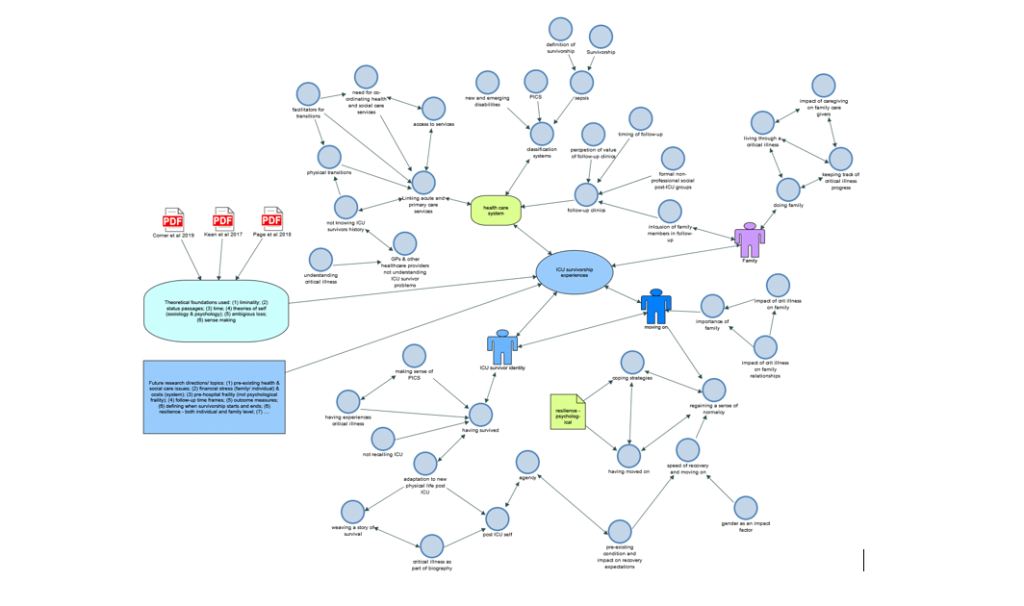
At this stage of the analysis, we were thinking about the linkages and hierarchies of theoretical concepts in our data set. Software packages, like NVivo, allow models to be “active” models, meaning one can play around with hierarchies and think through linkages with every change. Mapping alongside the developing analysis also functions as an audit trail of the data analysis and provides a structure for writing up at a later stage.
Analysis always requires the interaction with data, and this process of modeling allows the researcher to think theoretically about the data as well as deriving any ideas from the data because, as Atkinson (2015) argues “the end-point of analysis is not a knitting -together of coded themes” (p 62). It is this process that allows us to go beyond description to explanation and the process that too often is missing in much of qualitative work in nursing (Thorne 2020, Atkinson 2015).
In summary, mapping and modeling are data analysis techniques that are useful in developing analysis beyond description. These techniques help analysts to think through linkages of codes and hence the interpretation of data.
References:
Atkinson P (2015) For Ethnography, SAGE, London
Blaikie, N & Priest, J (2017) Social research – paradigms in action, polity
Coffey A & Atkinson P (1996) Making sense of qualitative data, SAGE, Thousand Oaks
Denzin N (2010) The qualitative manifesto. Left Coast Press, Walnut Creek
Flick U (2023) An Introduction to Qualitative Research, 7th edition, SAGE, Los Angeles
Saldaña J (2021) The coding manual for qualitative researchers, 4th edition, SAGE, Los Angeles Thorne S (2020) Beyond theming: making qualitative studies count (editorial), Nursing Inquiry, 27: e12343, doi.org/10.1111/nin.12343
As the holiday is approaching its good to discuss a little bit about occupational well-being. Occupational well-being in education (we are in this project as nurse educators) can be considered to consist of working conditions, work community, worker’s recourses and work, and professional competence. Working conditions includes physical, biological and chemical factors ja occupational safety. Work community refers to management, the working atmosphere, collegiality, and appreciation. Worker’s resources and work means the health, physical and mental fitness, the workload and occupational health care services. Professional competence refers to education, continues professional development and different areas of competence. (Saaranen et al. 2020.)
And how these aspects are visible in educators work and in this case project workers? For example, ergonomic furniture and equipment have a great impact on our health and well-being during and after a working day. Biological factors, such as social isolation during COVID-19 pandemic have had its own influence on our well-being in many ways. Because of COVID-19, we were unable to organize the first Kick-of meeting, and the first face-to-face meeting moved on for a year. Nevertheless, our project started well, and the meeting was replaced by virtual meetings.
An appreciative and supportive atmosphere and collaborative management improves employee satisfaction in their work (Arian et al., 2018). Based on research we can say that educators in health care are feeling that they are respected, and they get help and support from their colleagues (Saaranen et al., 2021). One of the best contributions of this project has been an inclusive and conversational atmosphere. In addition to the numerous virtual meetings, we have been able to meet face to face and openly discuss matters that are important to us. The feeling of cohesion has been tangible and confirmed we want to continue work together after this project. The power of co-operation brings a great sense of well-being. In addition, the project includes employees from many different career stages, and this can be seen as a great richness. We have all heard that competence brings confidence, but the competence of a more experienced colleague also gives confidence to the less experienced.
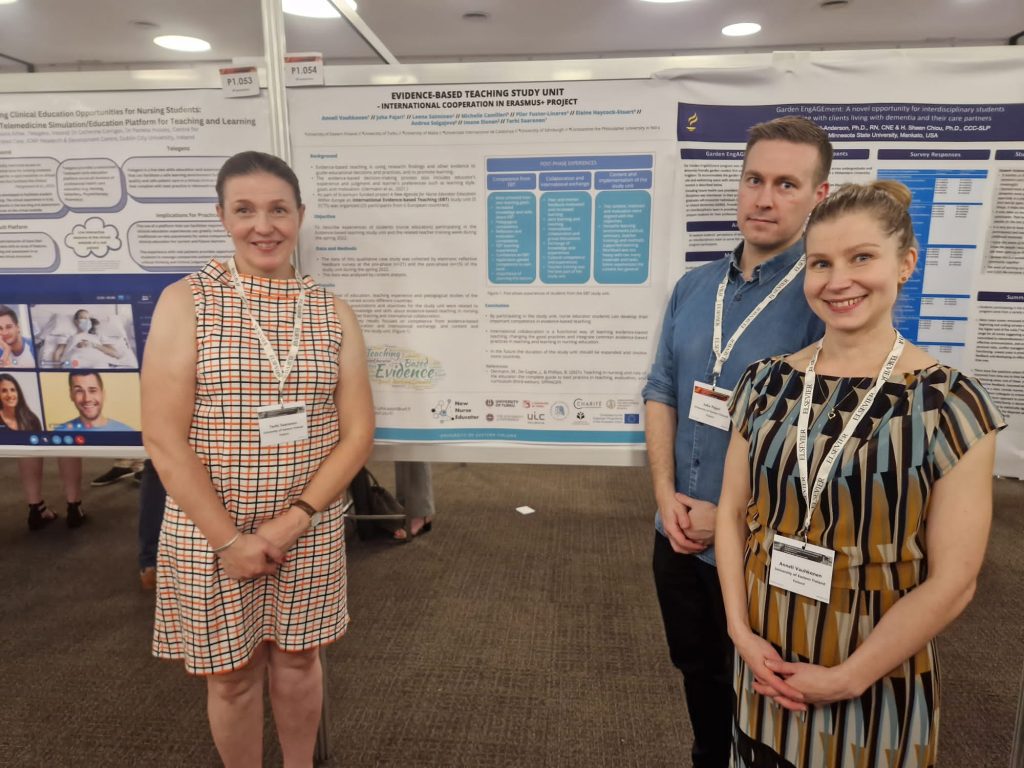
On the other hand, the work of educator is very independent (Arian et al., 2018) and that is partially why we like this work. Working hours are flexible and we can influence our working schedule. However, this involves the reverse side of the coin. When we are experiencing the great engagement to work, we may forget to take breaks in our work. The educator’s work is often more mentally than physically demanding (Saaranen et al., 2020), and often the amount of work is felt too heavy (Rinne et al., 2022). The peaceful Christmas holiday in approaching, but often the time before the holidays can feel nerve-wracking. As we know the work of educator is pretty hectic before holidays (Saaranen et al., 2020) and this is true also in the project work. The deadlines are coming closer, and we have hurrying to do all the work we have promised to do. We almost wish that there should be more hours in one day or an extra day in a week. However, we should not belittle our need to recover from the strain of work. Recovery from work means the process when we reduce or eliminate the psychical or mental strain caused by work (Sonnentag, 2015). There must be sufficient recovery between working days; although one of them likes more regular working hours every day and the other one likes a more intensive work week with a longer return. The main thing is that there is enough recovery from the work. We know that exercise, a meaningful hobby, good nutrition, and adequate sleep promotes our recovery from work and thus our well-being.

During busy days, it is good to consciously stop and think about the recovery from work during the working day. Recovery from work should start already during the working day and breaks are one of the most important ways to promote the recovery during the working day. By detaching ourselves from our work during the break and feeling that the break is meaningful is important for recovery and well-being (Virtanen et al., 2021). This can be for example something that we like to do, short walk outside, breathing or relaxing exercise (Rinne et al., 2020), or discussion (something else than work-related) with your colleague during your lunch break.
So we send a message to ourselves and to others: Take some time for yourself today, tomorrow and the coming weeks and do something relaxing in the middle of the day and between working days. By doing so, we can start our Christmas holiday with a better well-being and more relaxed. What could be your promise to yourself for the following year related to your well-being?
Anneli, Juha and Terhi
University of Eastern Finland, Department of Nursing Science
References:
Arian, M., Soleimani, M., & Oghazian, M. (2018). Job satisfaction and the factors affecting satisfaction in nurse educators: A systematic review. Journal of Professional Nursing, 34(5), 389–399. https://doi.org/10.1016/j.profnurs.2018.07.004
Rinne, J., Koskinen, S., Leino-Kilpi, H., Saaranen, T., & Salminen, L. (2021). Self-conductive interventions by educators aiming to promote individual occupational well-being—A systematic review. International Journal of Educational Research, 107, 101755–. https://doi.org/10.1016/j.ijer.2021.101755
Saaranen, T., Kankkunen, P., & Juntunen, A. (2020). Terveysalan opettajien työhyvinvointi ja sen edistäminen – työntekijän ja hänen työnsä näkökulma. (The status and promotion of the occupational well-being of health care teachers – the perspective of workers and their work.) Journal of Nursing Science, 32(3), 154–165. (Abstract in English)
Saaranen, T., Kankkunen, P., & Mönkkönen, A. (2021). Occupational wellbeing through community factors – questionnaire survey to health educators. (Työyhteisötekijöillä työhyvinvointia – kyselytutkimus terveysalan opettajille.) Tutkiva Hoitotyö, 19(3), 32–39. (Abstract in English)
Sonnentag, S., & Fritz, C. (2015). Recovery from job stress: the stressor‐detachment model as an integrative framework. Journal of Organizational Behavior, 36(1), 72–103. https://doi.org/10.1002/job.1924
Virtanen, A., Van Laethem, M., de Bloom, J., & Kinnunen, U. (2021). Drammatic breaks: Break recovery experiences as mediators between job demands and affect in the afternoon and evening. Stress and health : journal of the International Society for the Investigation of Stress, 37(4), 801–818. https://doi.org/10.1002/smi.3041
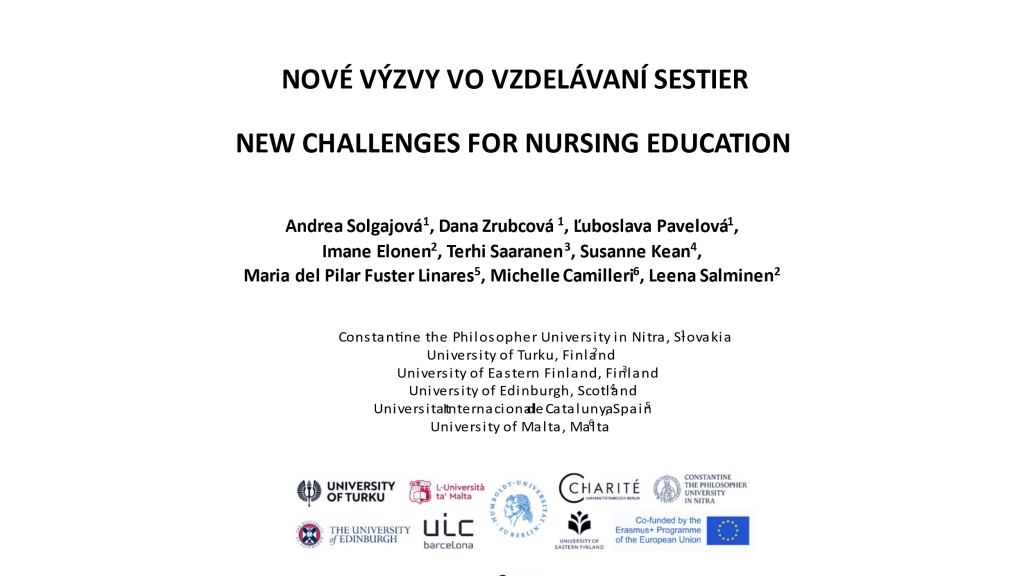
Nowadays knowledge and experience are considered to be significant assets for sustainable success of projects. Sharing them properly through appropriate examples, cases, and justification of successes or failures offers better estimation of the project efforts among the stakeholders.
The Department of Nursing, Faculty of Social Sciences and Health Care, Constantine the Philosopher University in Nitra, Slovakia, organised a two-day International Symposium “Nursing of the 21st Century in the Process of Changes 2022” on 8 and 9 September 2022. The meeting of experts from the universities in the Czech Republic, Hungary, Poland and Slovakia brought many interesting and stimulating speeches focused on research findings and linking theory with practice.

On behalf of all the participants of the New Agenda for Nurse Educator Education in Europe Project, Andrea Solgajová, Dana Zrubcová and Ľuboslava Pavelová informed the professionals on the nature, structure and implementation of the project intentions. We clarified the Project evidence-based recommendations for health policy makers of all the European countries and the EHEA countries. We discussed on nurse educator education and possibilities of enhancing educators’ knowledge, skills and professionalism.
There was the fruitful discussion about education for nursing students and their equal possibilities for high-quality education in Europe. The attention was also drawn to the content and course of education in the five Project modules.

Sharing the Project experience and achieved knowledge gives a possibility for new collaborations and to become more efficient in the development of the field of nursing internationally. Therefore, it is important to share experiences, best practice, opinions and ideas with project managers.
All the discussion participants recognised the importance of developing pedagogical competence and enhancement of collaboration in educator education and training in the EU. They recognised the Project as an effective education programme for nurse educators reflecting on current changes in health care.
Authors: Ľuboslava Pavelová, Andrea Solgajová, Dana Zrubcová and Tomas Sollar from Constantine the Philosopher University in Nitra.

The 8th NETNEP conference was organized in the end of October 2022, in Sitges, Spain with the theme “From education to impact: Transforming nursing and midwifery education”. From the beginning the NETNEP conference aimed to facilitate the sharing of knowledge and experience of nursing, midwifery and healthcare education worldwide and NETNEP 2022 continues this aim by encouraging the sharing of research and practice of nursing, midwifery and healthcare education. Moreover, the conference gave the possibility to discuss with colleagues and network. Especially, in the poster hall, there were a lot of interesting discussions.
This year there were more than 800 delegates. The programme consisted of keynote presentations, oral and poster presentations – including the Rapid-5 short oral communications and also some workshops. The topics of the conference was: 1) Teaching & assessment, 2) Learning in practice – Clinical education, 3) New technologies, simulation and social media in teaching and practice, 4) Curriculum innovation & development, 5) Evidence and educational discourse, 6) Research, scholarship and evaluation and 7) Professional development & leadership.
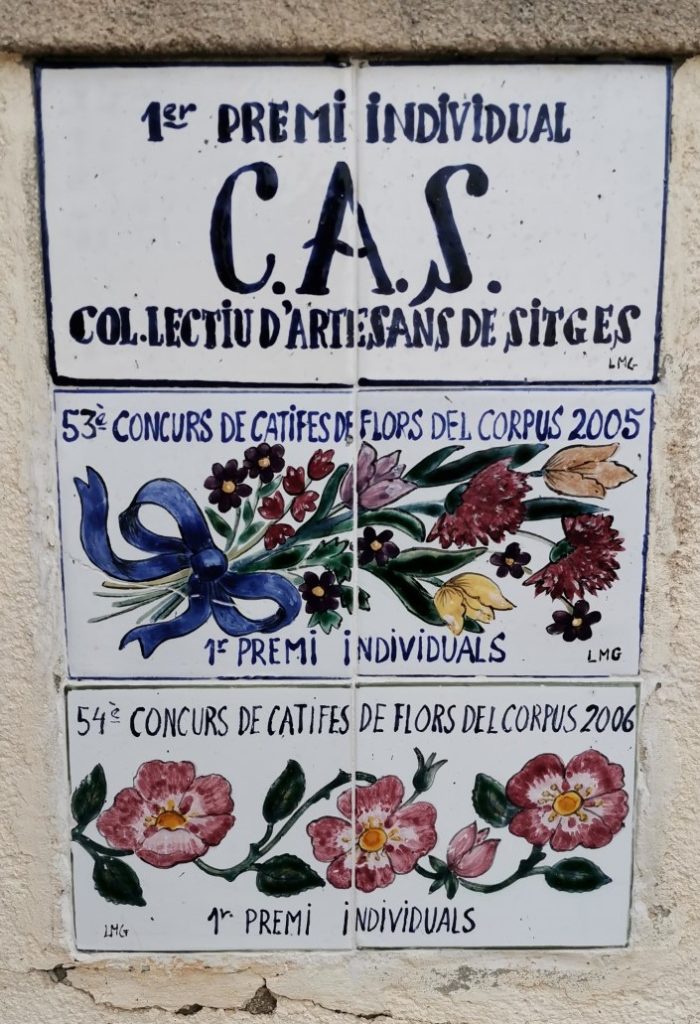
The first keynote speaker Dr Hester Klopper from the Stellenbosch University in South Africa spoke the Global trends and transformation: Implications for nursing and midwifery education. She brought up in developing the nursing and midwifery curricula the importance of interprofessional and transdisciplinary, collaboration, social justice for health, pandemic response and skills se for the future, both hard and soft skills.
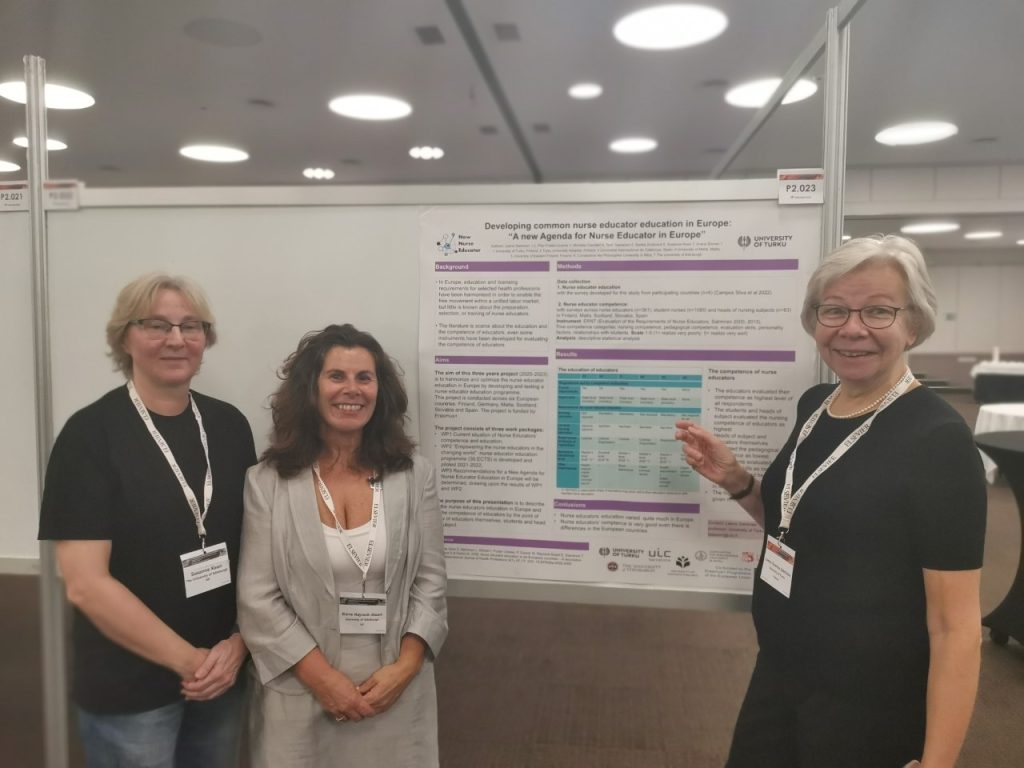
Most of the presentations concerned the nursing education, the students experience of education, their learning outcomes and use of different kind of teaching methods in teaching. New technologies and digital pedagogy were well presented. Much less was educator education, role and competence featured. Therefore, our New Nurse Educator -project was a good addition for this topic with total of four posters and two oral presentations.
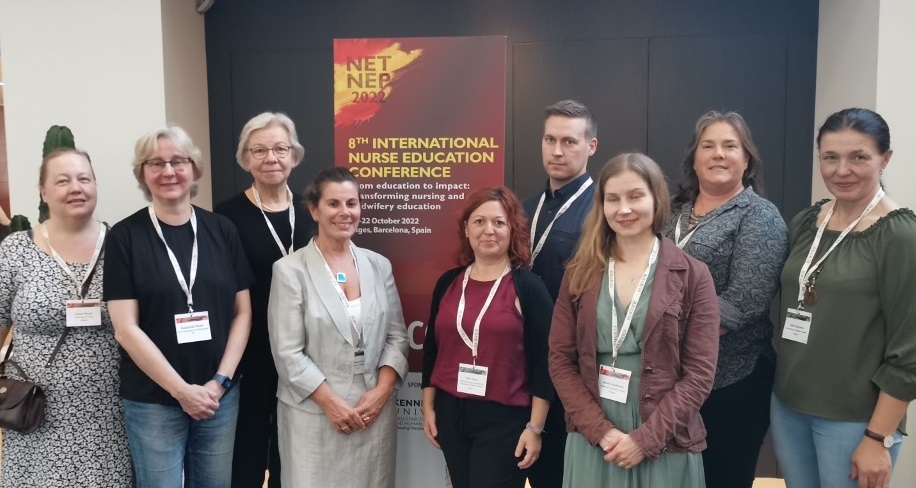
As a summary can be said that the conference was organized very nicely, the programme was good, there were a lot of different kind of presentations. The quality of the presentations was varying as it always is in this kind of large conferences. Sitges, the small town in Catalunya was an exquisite place and sun was shining all the time. Already waiting for the next NETNEP conference, even the topics, the place and the dates are not yet informed.

Thankyou Sitges, you were good to us!
Authors of the blog:
Dr. Pilar Fuster-Linares
Dr. Leandra Martin Delgado
Dr. Laia Wennberg Capellades
From Universitat Internacional de Catalunya, Barcelona, Spain
The concept of ethical dilemmas has been broadly explored in nursing because of the prevalence of this dilemmas in daily practice (1,2). As nurses we understand the need and importance of having ethical standards in our profession. In 2021, the ICN reviewed and updated the Code of Ethics for Nurses, a statement of the ethical values, responsibilities and professional accountabilities of nurses that defines and guides ethical nursing practice. This document includes the changes that appear in the working environments and the new challenges and dilemmas that have appeared due to the COVID-19 pandemic (3).
Faced with these new elements and in order to show the essence of the ethics of care in the different professional roles, nursing educators must also be updated, not only in the content of the Code of Ethics, but also in the ways in which it is incorporated into nursing curricula.
Although ethical dilemmas are frequent in day-to-day life of the nursing professional, it is difficult for nursing students to identify situations potentially susceptible to be recognized as ethical dilemmas, due to their lack of knowledge of the professional role, their lack of clinical practice or even their lack of autonomy to make decisions in the clinical environment among others (4). For this reason, it is important to work on ethical dilemmas through methodologies that facilitate and stimulate reflection, but that in turn propose situations that students can understand and analyse even if they have not lived them.
Several studies have shown that education through films helps to improve teaching skills and stimulates learner reflection (5,6). Films could be considered as “the audio-visual version of storytelling (….) The cinema experiences act like emotional memories for developing attitudes and keeping them as reflective reference in the daily activities and events” (Blasco, P. et al Journal for Learning through the Arts, v22, n1,2015).
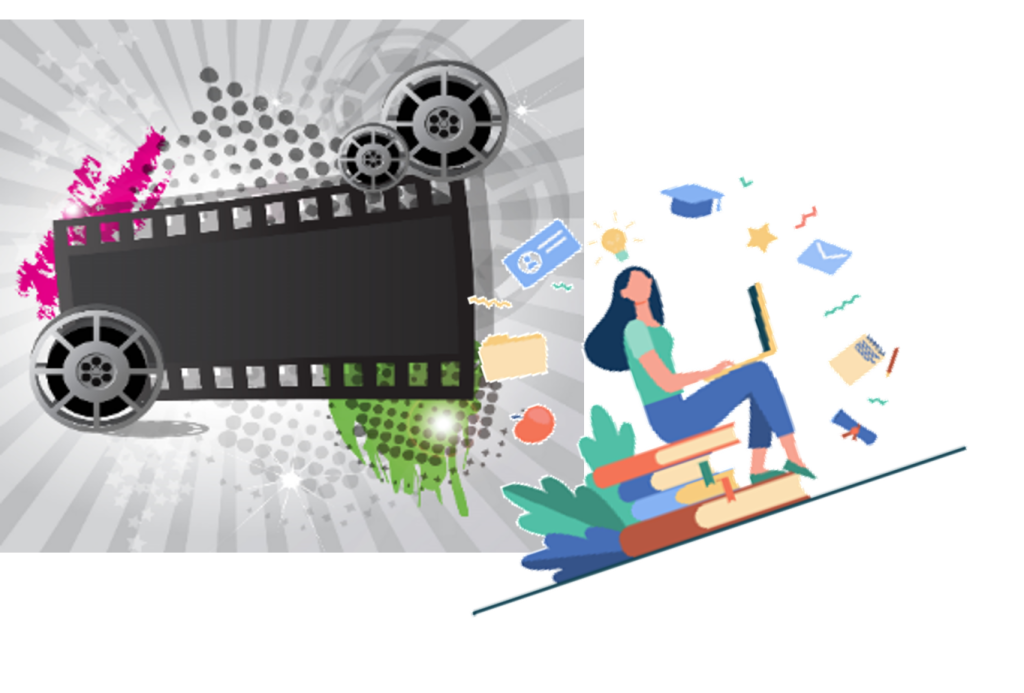
In our case, we incorporate the methodology of reflection through the cinema precisely to offer nurse educators the possibility of experiencing the possibilities of this methodology. We used the film Wit (2001), in which the leading actress Vivian (Emma Thopmson) shares her experience of illness with the viewer, and makes him a participant in her decisions, her experiences and her thoughts. Through the magic of the cinema, Vivian forces us to feel and be moved by her experience, and leads us to reflect on aspects of the nursing profession in a complex situation that is not always evident to us. But above all it allows us to do it from the perspective of the patient and through our own emotion, adding the value of the “experience” to something that priori, could be totally external to us.
This methodology allows us to empathize with the other from the safety of our home, it also allows us to live and relive those moments that cause us more doubt, more surprise or more indignation. We can analyse, dissect and reflect on what we see, but also on what makes us feel what we see, and that part of emotion, adds value to the learning experience, helping to develop concepts and to strongly record elements, in this case of professional ethics.
REFERENCES
1- Rainer, J., Schneider, J. K., & Lorenz, R. A. (2018). Ethical dilemmas in nursing: An integrative review. Journal of Clinical Nursing, 27(19-20), 3446-3461.
2- Koskimies, E., Koskinen, S., Leino‐Kilpi, H., & Suhonen, R. (2020). The informational privacy of patients in prehospital emergency care—Integrative literature review. Journal of Clinical Nursing, 29(23-24), 4440-4453.
3- Sperling, D. (2021). Ethical dilemmas, perceived risk, and motivation among nurses during the COVID-19 pandemic. Nursing Ethics, 28(1), 9-22.
4- Albert, J. S., Younas, A., & Sana, S. (2020). Nursing students’ ethical dilemmas regarding patient care: An integrative review. Nurse Education Today, 88, 104389.
5- Blasco, P. G., Moreto, G., Blasco, M. G., Levites, M. R., & Janaudis, M. A. (2015). Education through Movies: Improving teaching skills and fostering reflection among students and teachers. Journal for Learning through the Arts, 11(1), n1.
6- Jerrentrup, A., Mueller, T., Glowalla, U., Herder, M., Henrichs, N., Neubauer, A., & Schaefer, J. R. (2018). Teaching medicine with the help of “Dr. House”. PLoS One, 13(3), e0193972
Authors: Ľuboslava Pavelová, Constantine the Philosopher University in Nitra & Imane Elonen, University of Turku
“My first “gentle” touch with the subject of ethics was at the beginning of my Nursing studies in 1988 (I have a nostalgic smile on my face right now). Initially it was an uninteresting subject for me, based on theory and philosophy only and I couldn’t really understand.”
Ethics education, as all education, has traditionally been lecture based in all health sciences and in nursing. Furthermore, it was more focused on theoretical knowledge on philosophical base of ethics and learning the codes, rather than engaging in ethical problem solving or providing tools to do that. (Woods, 2005.)
“ Subsequently, as a nurse in clinical practice, I knew about the code of ethics, I respected the four main principles in the provision of nursing care and somehow intuitively solved ethical issues, dilemmas.”
Education in health sciences and ethics, has come a long way since and there is great amount of information on evidence based teaching in ethics. Problem based learning (PBL), Case based learning (CBL), simulations, games and others (Opsahl et al., 2020; Herron et al., 2019; Namadi et al., 2019; Srinivasan et al., 2007).
The study unit Ethics and Nurse Educators’ Work, which was the final of the five study units forming the Empowering Nurse Educators in the Changing World (ENEC) study programme organized by the Erasmus+ funded project “New Nurse Educator”, utilised case-studies as the method of teaching. Knowing the effectiveness of CBL (Herron et al., 2019; Namadi et al., 2019), the organizers wanted to ensure the participants don’t only learn ethics of nurse educators but may also rediscover the effectiveness and acceptability of CBL in ethics education.
CBL has its benefits in teaching ethics, especially in time constricted, fairly intensive study units, as the study units within the ENEC study programme (Herron et al., 2019; Namadi et al., 2019 Srinivasan et al., 2007). Compared to similarly effective method, PBL, CBL provides clearer structure and more streamlined approach, enabling students to reach conclusion with less time and effort, yet demanding them to develop their problem solving skills and engage in collaborative inquiry to reach their goal (Srinivasan et al., 2007). CBL has been proven an effective and preferable method in ethics education, and it equips the students with necessary problem solving skills (Namadi et al., 2019).
“Later, as a teacher, I introduced the students – future nurses to the moral, ethical requirements, rules, principles to be followed in the performance of daily nursing activities. Being “here” today in 2022 (I have a satisfactory smile on my face) I am at the end of graduating from the educational module “ethics and nurse educators work” within the Empowering the nurse educators in the changing world (ENEC) – study program. My role as a teacher enriched by the fact that the current, dynamically evolving time demands in the educational process to not only use the classical teaching methods, but also less traditional ones. Those that can inspire and make students to work independently, in finding appropriate solutions to ethical issues and dilemmas in diligence. “
In addition to traditional word based case scenarios, there are promising results, in utilising case videos, they may further enhance both learning and acceptability in students (Herron et al, 2019). The study unit “Ethics and Nurse Educators’ Work” was completed by majority of the registered students. The case studies were engaging and students represented their cases during the final webinar of the whole one-year ENEC programme, prompting fascinating and inspiring international discussions, which hopefully will inspire the educators and educator candidates further in their educator careers.
“I want to set my work to a new direction. I am empowered to promote a culture of ethical behaviour for students – future nurses. I am ready to talk to students about ethics and adherence to ethical principles, to encourage them to discuss their concerns about their ethical dilemmas without fear of retaliation. I support open and continuous communication between us and I want to act as a positive role model for them. Thank you for this opportunity!”
Srinivasan, M., Wilkes, M., Stevenson, F., Nguyen, T., & Slavin, S. (2007). Comparing problem-based learning with case-based learning: effects of a major curricular shift at two institutions. Academic Medicine, 82(1), 74-82.
Namadi F, Hemmati-Maslakpak M, Moradi Y, Ghasemzadeh N. The effects of nursing ethics education through case-based learning on moral reasoning among nursing students. Nurs Midwifery Stud 2019;8:85-90
Opsahl, A., Nelson, T., Madeira, J., & Wonder, A. H. (2020). Evidence‐Based, Ethical Decision‐Making: Using Simulation to Teach the Application of Evidence and Ethics in Practice. Worldviews on Evidence‐Based Nursing, 17(6), 412-417.
Herron, E. K., Powers, K., Mullen, L., & Burkhart, B. (2019). Effect of case study versus video simulation on nursing students’ satisfaction, self-confidence, and knowledge: A quasi-experimental study. Nurse education today, 79, 129-134.
Woods, M. (2005). Nursing ethics education: are we really delivering the good (s)?. Nursing ethics, 12(1), 5-18.
